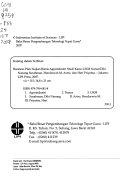This dissertation, "Geochemistry, Geochronology and Isotope Geochemistry of Eocene Dykes Intruding the Ladakh Batholith" by Alexandra Regina, Heri, was obtained from The University of Hong Kong (Pokfulam, Hong Kong) and is being sold pursuant to Creative Commons: Attribution 3.0 Hong Kong License. The content of this dissertation has not been altered in any way. We have altered the formatting in order to facilitate the ease of printing and reading of the dissertation. All rights not granted by the above license are retained by the author. Abstract: Eocene dykes intruding the Ladakh batholith were sampled along the southern margin of the Trans-himalayan plutonic arc in Ladakh, NW-India. Approximately 30 dykes were encountered in the 40 km trail between Leh and Hemis Shugpachan. The dykes in the east of the field are trending E to NE and those in the west trending N to NW, exhibiting sub-parallel orientations within each area. Eighteen dykes were sampled (two of them multiple times) and subjected to petrographic, geochemical and isotopic analyses. They exhibit various degrees of differentiation from basaltic to rhyolitic compositions and are mainly composed of plagioclase, quartz, hornblende (s.l.) and/or biotite and magnetite. Furthermore, dykes in the eastern part of the field area contain quartz xenocrysts resulting from crustal assimilation, while no relict quartz was found in the west. The dykes exhibit alteration phases and features suggesting that they underwent autometamorphism, i.e. hydration reactions due to igneous cooling. Whereas the dykes in the east of the field area record low-T alteration, the mineral parageneses in the west are typical for alteration at elevated temperatures typical for greenschist metamorphic facies. Al-in-hornblende barometry performed on Magnesio-hornblende and Tschermakitic-hornblende phenocrysts of the least altered dyke indicates formation in upper-amphibolite metamorphic facies conditions and pressures of about 6 kbar corresponding to an intrusion depth of approximately 20 km. Major and trace element analyses and Rb-Sr and Sm-Nd isotope analyses revealed a stunning variability in geochemistry and isotopic composition amongst the coeval dykes. All dykes exhibit LREE enrichment and HREE depletion as well as negative Tb and Nb anomalies characteristic for subduction-related intrusives and extrusives. Their REE patterns support a clear subdivision into chemically distinct groups. The group hypothesis was further tested and found valid using statistical tools designed to assess similarity/dissimilarity amongst individuals of a group with a common ancestor, such as hierarchical cluster analysis and multidimensional scaling. The dykes are cogenetic, but clearly not consanguineous, i.e. have not formed from one, progressively differentiating magma chamber. The variability observed in Sr-Nd isotopes can be explained by the dykes having undergone differing degrees of crustal assimilation. In particular the dykes in the east containing quartz xenocrysts show negative iiNd) and positive N(Sr) values caused by crustal assimilation, whereas the dykes in the west with no quartz xenocrysts exhibit positive qqNd) and N(Sr) near zero. 39Ar-40Ar dating by incremental heating of several hornblende-bearing dykes revealed crystallization ages between 50 and 54 Ma, whereas two biotite-bearing dykes gave ages of 45 and 37 Ma, likely to be cooling or recrystallisation ages. The combination of structural field evidence with petrographic, petrologic, geochemical, isotopic and geochronological analyses demonstrates that the dykes, although sharing a common origin, i.e. having formed in the same tectonic setting at roughly the same time, have undergone further geological processes leading to an unexpected diversification of the dykes. These findings provide ample scope for further in-depth and breadth investigations on "late-magmatic dykes" in the future. DOI: 10.5353/th_
This dissertation, "Geochemistry, Geochronology and Isotope Geochemistry of Eocene Dykes Intruding the Ladakh Batholith" by Alexandra Regina, Heri, was obtained from The University of Hong Kong (Pokfulam, Hong Kong) and is being sold ...









